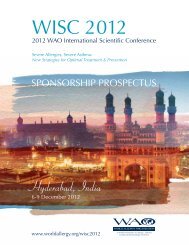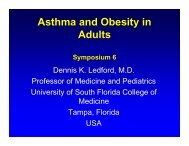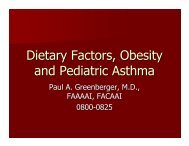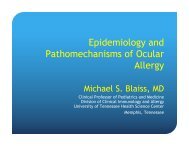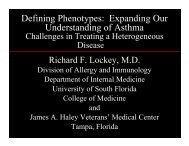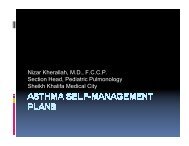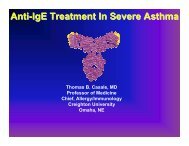Dubai Final-v20.indd - World Allergy Organization
Dubai Final-v20.indd - World Allergy Organization
Dubai Final-v20.indd - World Allergy Organization
You also want an ePaper? Increase the reach of your titles
YUMPU automatically turns print PDFs into web optimized ePapers that Google loves.
ABstrACts<br />
mWCnts on OVA-asthma model were analyzed by airway hyperreactivity (AHr) measurement, bronchoalveolar lavage fluid (BAlF)<br />
analysis, intracellular rOs production and histological analysis in lung tissue.<br />
Results: intranasally administrated-mWCnts easily loaded in alveolar macrophage, but did not result in significant lung<br />
inflammation and intracellular rOs production of the OVA-induced asthma model. in histological analysis, mWCnts exacerbated<br />
collagen deposition within the lung parenchyma of naïve mice and pre-existing allergic mice.<br />
Conclusion: these results suggest that combined OVA sensitization and mWCnts administration did not affected pre-existing<br />
allergic, but increased collagen deposition in lung parenchyma.<br />
1111<br />
PollEn CoUnTS ProFilE in gEorgia EValUaTED BY THE BUrKHarD PollEn TraP<br />
Chikhladze, m. V. 1 and sepiashvili, r. i. 2<br />
1 2 national institute of Allergology, Asthma & Clinical immunology, georgian Academy of sciences, tskhaltubo, georgia. Department<br />
of Allergology and Clinical immunology, institute of immunophysiology, moscow, russia.<br />
Aim and Methodology: the pollen counts in georgia were studied in 2006-2009 using the vacuum Burkhard Pollen trap (great<br />
Britain) donated by the <strong>World</strong> <strong>Allergy</strong> <strong>Organization</strong> (WAO) to the national institute of Allergology, Asthma and Clinical immunology<br />
in tskhaltubo (georgia). the dependence of allergic diseases prevalence on the geographic location and some other factors (air<br />
temperature, humidity, height above the sea level, spectrum of regional plants) were also studied.<br />
Results: it was stated that allergy to mold fungi and other bacteria more often occurred in the areas with high humidity and the<br />
morbidity level with hay fever and bronchial asthma was much higher than in dry areas. in cities situated on the Black sea (Batumi,<br />
Kobuleti, Poti), ragweed is widely distributed, which in the period of blossom caused numerous allergic diseases (allergic rhinitis,<br />
conjunctivitis, urticaria etc.). When ragweed blossom, the quantity of pollen in the air is extremely high and as it is a strong allergen<br />
it causes exacerbation and allergic disease in people sensitized to ragweed pollen. the highest percentage of allergy morbidity<br />
fall at plants allergens caused by pollen of numerous weeds and plants (pollen of ragweed, alder, birch, maple, walnut, mallow,<br />
cotton-plant etc.). in different areas of georgia people are more sensitive to various plants. in imeretia region, it is ragweed pollen,<br />
in Kakhetia and Kartli – platan and wheat. graphic chart of hay fever and bronchial asthma morbidity as a rule have two peaks –<br />
spring–summer and autumn–winter. it is the season of plants blossom and the quantity of pollen in the air is most high.<br />
Conclusion: the pollen counts obtained using the Burkhard Pollen trap allowed us to make a pollen calendar for different regions<br />
of georgia thus enabling to perform treatment and prophylactic measures in advance.<br />
1112<br />
air PUriFiEr THaT USES PHoTo CaTalYTiC oXiDaTion rEDUCED THE PoPUlaTion oF mrSa<br />
ghosh, n. 1 , Pratt, C. 1 , Bennert, J. 2 , Chudasama, J. 2 and Das, A. B. 3<br />
1 2 3 life, Earth and Environmental sciences, West texas A&m University, Canyon, tX. Air Oasis, Amarillo. Dept. of Agricultural<br />
Biotechnology, College of Agriculture, Orissa University of Agriculture & technology, india.<br />
the air surrounding us plays an extremely important role in our well being and efficiency. Breathing pure and clean air allows us to<br />
think more clearly, sleep more soundly, and stay healthier. studies show that we receive 56% of our energy from the air we breathe,<br />
more than from water and food combined. On average we breathe 37 pounds of air a day. the quality of the environment within<br />
buildings is a topic of major importance for public health and indoor Air Quality (iAQ) is a major concern at work places. the objective<br />
of the present study was to assess two negative ion purifiers - Xtreme 3000 and luna induct air purifiers on the net reduction of<br />
bacteria in the microbiology and mycology laboratories of Baptist saint Anthony’s Hospital (BsA) in Amarillo, texas and the specific<br />
effect on methicillin resistant Staphylococcus aureus, mrsA. mrsA has become a serious public health issue. luna induct air units use<br />
an advanced hydrated Photo-Catalytic Oxidation (PCO) filtration system. it produces a broad spectrum high intensity UV light targeted<br />
on a quad metallic catalyst in a low-level ozone and moist atmosphere. Bacteria isolated from petri plates exposed to the room air<br />
were gram positive bacilli such as Bacillus, Coryneform (diptheroids), coagulase negative Staphylococcus and Micrococcus spp., and<br />
encapsulated gram negative bacilli. in every case there was reduction in airborne pathogen with variable room sizes when the air<br />
purifiers were used. tsA plates with 5% sheep blood were placed for exposure rooms at different distances and intervals. Plates were<br />
evaluated for the total number of bacterial and fungal colonies at intervals of 24, 48, 72 and 120 hours. We plated the mrsA strains<br />
from the stock culture after dilution 10-4 to investigate the effect of air-purifiers on the production of number of colonies of mrsA. tsA<br />
plates were inoculated with the strain after serial dilutions as follows. 5 ml of stock culture was diluted to 10-4 after incubation at 37o C for 24 hours and were plated onto tsA petri plates. ‘t-test’ results show that there was a significant difference in the air purifier<br />
treated sets and a gradual reduction in the number of colonies. the reduction of latent bacteria in the air could possibly reduce the<br />
transmission of airborne disease.<br />
www.worldallergy.org 83<br />
FinAl PrOgrAm<br />
ABstrACts



